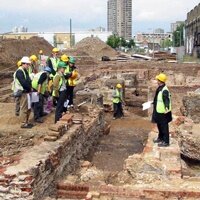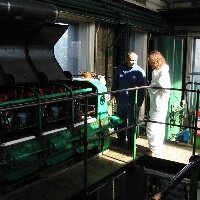Local Authority Historic Environment Service


Local authorities are responsible for the conservation of 95% of the historic environment including Listed Buildings, archaeological sites and monuments, historic landscapes, historic parks and gardens and historic battlefields. Local Authorities also work in partnership with English Heritage on the conservation of Scheduled Monuments and Grade 1 and 2* Listed Buildings. All Local Planning Authorities are required to have access to conservation and design skills.
Local authority historic environment services are non-statutory and have evolved to meet the needs of local communities and local political circumstances. These services are therefore widely variable in terms of the type of local provision, their size and the resources available. Although local historic environment services continue to change and evolve, there are several service models which between them include the vast majority of services.
The following is a brief description of these models which we hope will help you place your own service within the broad local government sector:
County Councils
All county councils in England maintain historic environment or archaeological services. Their size, and therefore the range of activities carried out by these services varies, but the following are key, common aspects of county based services:
- The provision of archaeological advice on strategic and development control planning to county, district and borough councils within their areas,
- The maintenance of the local Historic Environment Record (also known as a Sites and Monuments Record) which contains a wide range of information about sites, buildings, landscapes and settlements of historic and archaeological interest,
- Advice to a wide range of other organisations concerning development and land-use change not controlled through the planning system e.g. infrastructure projects and utility services,
- Advice to landowners and land managers about the management of the rural historic environment. This includes supplying archaeological advice to Defra on agri-environment schemes and to the Forestry Commission on the planting and management of woodland,
- Working with local communities through education and outreach programmes to promote better intellectual and physical access to the historic environment, and the skills needed for maintaining it
- Advising the Council’s own departments on management of and works to historic buildings and archaeological sites, highway works affecting historic buildings and conservation areas, etc.
- Providing specialist advice, in liaison with District Councils, on historic buildings especially where these will be affected by development and other changes and where assessment and recording is required. The extent of such advice depends on the Conservation Officer provision within the local planning authorities, and the need for particular specialist skills which may be available at County level.
Urban and rural District and Borough Councils within two-tier local authority areas.
All Local Planning Authorities are required to have access to Conservation and Design skills, either in-house or externally provided. All local authorities which have a significant number of Listed Buildings and Conservation Areas, are likely to have a Conservation Service. Effective delivery of the service depends on good links with other regulators; the model generally best suited to effective delivery is for the Conservation Service to be provided within the Planning Department.
The following are key elements of Conservation Services:
- giving advice to owners of historic buildings on repairs and alterations;
- advising their own and other Council departments on the management of and works to the authority’s own historic buildings and spaces;
- advising the local planning authority on developments, and briefs for them, affecting Listed Buildings, Conservation Areas, and Buildings of Local Interest;
- negotiating, and instigating legal action where necessary, in relation to unauthorised works;
- mediating and resolving other regulators’ requirements (Building Regulations, DDA, Environmental Health) affecting historic buildings;
- catalysing and promoting regeneration and enhancement schemes, and refurbishment of individual buildings;
- providing input to Local Development Frameworks and other departmental and corporate policy documents and strategies;
- reviewing Conservation Area boundaries, and carrying out the designation of Conservation Areas, Local Lists etc, in consultation with the public and amenity bodies;
- drafting Conservation Area Appraisals and other Supplementary Planning Guidance / Documents on Conservation and Design matters;
- promoting understanding of the Historic Environment, and the skills needed to maintain it and enhance it, through lectures, organising training events, Design Awards, supporting the work of Heritage and Design Champions, etc;
- maintaining records/archives relating to historic buildings and areas, in liaison with the County Historic Environment Record.
District and borough councils in two-tier areas generally do not provide advice on archaeology or historic landscapes and do not maintain formal historic environment records.
The exceptions to this model are the major historic towns and a few rural districts with large archaeological resources. These have archaeological services broadly equivalent to those within unitary authorities and county councils although they generally do not maintain historic environment records.
Unitary Authorities
As with district and borough councils in two-tier areas, most unitary authorities that include large and important collections of historic buildings, especially Listed Buildings and Conservation Areas, have a Conservation Service. In addition, many Unitary Authorities maintain archaeological services or have joint arrangement or SLAs with another authority to provide such a service. Archaeological services advise local planning authorities on the archaeological implications of development as well as development that does not require planning permission. Archaeological services also advise farmers and landowners in rural areas on management of the historic environment, including advice of grant-aid. In addition, many maintain historic environment records.
London
In the absence of a central planning authority for Greater London, English Heritage provides archaeological advice to 31 boroughs, while the City of London and Southwark have their own archaeology officers. These services are comparable to the role of County Council historic environment services elsewhere in the country.
National Park Authorities
All National Park authorities in England maintain historic environment services. These are broadly equivalent to historic environment services in rural county councils and unitary authorities and advise on historic buildings, including Listed Buildings, Conservation Areas and archaeological sites and landscapes. They also advise on local development frameworks and development control planning. They provide a service to a wide range of people and organisations on development and land-use outside the planning system and advise land owners and managers on conservation of the rural historic environment through, for example, forestry and agri-environment schemes. They also engage in education and outreach programmes providing physical and intellectual access to the historic environment. Some national park authorities maintain historic environment records.
What's New?
-
Welcome to the HER21 page. This page offers access to the full suite of HER21 project reports.
-
Please help us to improve our website by completing a short survey and you could win a book of historic photographs
